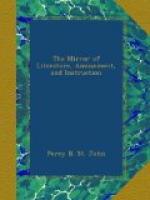A gentleman occupied a farm in Essex, where he had not long resided before numerous rooks built their nests on the trees surrounding his premises; the rookery was much prized; the farmer, however, being induced to hire a larger farm about three quarters of a mile distant, he left the farm and the rookery; but, to his surprise and pleasure, the whole rookery deserted their former habitation and came to the new one of their old master, where they continue to flourish. It ought to be added, that this gentleman was strongly attached to all animals whatsoever, and of course used them kindly.
The Swallow, Swift, and Martin, seem to have almost deserted London, although they are occasionally, though not very plentifully, to be seen in the suburbs. Two reasons may be assigned for this relative to the swallow; flies are not there so plentiful as in the open country; and most of the chimneys have conical or other contracted tops to them, which, if they do not preclude, are certainly no temptation to their building in such places; the top of a chimney being, as is well known, its favourite site for its nest. The Martin is also scarce in London. But, during the summer of 1820, I observed a Martin’s nest against a blind window in Goswell Street Road, on the construction of which the Martins were extremely busy in the early part of the month of August. I have since seen many Martins, (August, 1826,) busily engaged in skimming over a pool in the fields, to the south of Islington: most of these were, I conjecture, young birds, as they were brown, not black; but they had the white on the rump, which is characteristic of the species. A few days afterwards I observed several Martin’s nests in a blind window on Islington-Green. And, Sept. 20, of the same year, I saw from the window of my present residence, in Dalby Terrace, City Road, many similar birds actively on the wing.
The Redbreast has been, I am told, occasionally seen in the neighbourhood of Fleet-market and Ludgate-hill. I saw it myself before the window of my present residence, Dalby Terrace, in November, 1825, and in Nov. 1826, the Wren was seen on the shrubs in the garden before the house at Dalby Terrace; it was very lively and active, and uttered its peculiar chit, chit.
The Starling builds on the tower at Canonbury, in Islington; and the Baltimore Oriole is, according to Wilson, found very often on the trees in some of the American cities; but the Mocking-bird, that used to be very common in the American suburban regions, is, it is said, now becoming more rare, particularly in the neighbourhood of Philadelphia.
The Thrush was also often heard in the gardens behind York-place, during the spring of 1826. I heard it myself in delightful song early in March, 1826, among the trees near the canal, on the north side of the Regent’s Park.




